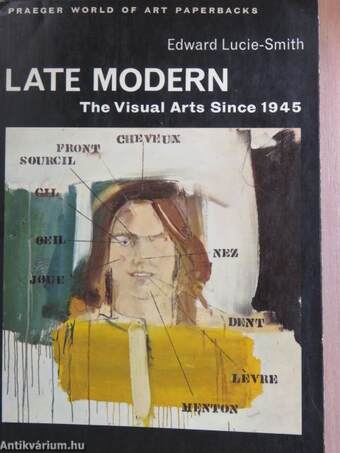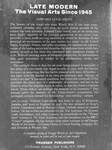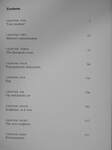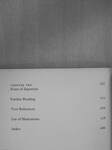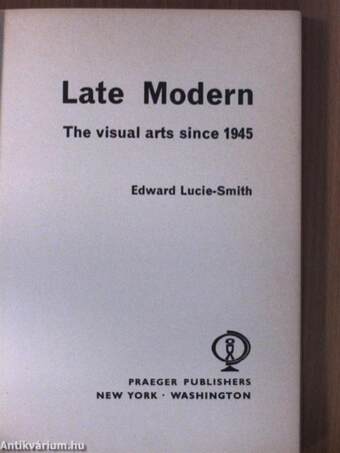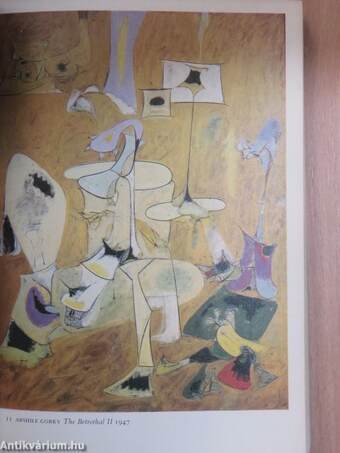1.076.483
kiadvánnyal nyújtjuk Magyarország legnagyobb antikvár könyv-kínálatát

VISSZA
A TETEJÉRE
JAVASLATOKÉszre-
vételek
Late Modern
The visual arts since 1945
| Kiadó: | Praeger Publishers |
|---|---|
| Kiadás helye: | New York |
| Kiadás éve: | |
| Kötés típusa: | Ragasztott papírkötés |
| Oldalszám: | 288 oldal |
| Sorozatcím: | Praeger World of Art Paperbacks |
| Kötetszám: | P-249 |
| Nyelv: | Angol |
| Méret: | 21 cm x 15 cm |
| ISBN: | |
| Megjegyzés: | Számos fekete-fehér és néhány színes fotóval, reprodukcióval. További kapcsolódó személyek a kötetben. |
naponta értesítjük a beérkező friss
kiadványokról
naponta értesítjük a beérkező friss
kiadványokról
Fülszöveg
LATE MODERN
The Visual Arts Since 1945
EDWARD LUCIE-SMITH
The history of the visual arts since World War II has been extra-ordinarily compléx, and, until now, no good concise account of the subject has been available. Edward Lucie-Smith, one of the ablest and most highly regarded of the younger generation of art critics, here provides a clear, swift-moving narrative in which he discusses all the principal art movements of the past twenty-five years—in the United States, England, Francé, and other countries. He analyzes the achieve-ments of the leading artists and describes the traditions from which they sprang, as well as the ideas that prompted each successive change in style. With an unerring sense of historical perspective, he demonstrates how each movement is related to its predecessors, rivals, and successors.
The author's thesis is that the art now being created is essentially a late phase of a movement that began as early as 1905, with the Fauves. He sees it as... Tovább
Fülszöveg
LATE MODERN
The Visual Arts Since 1945
EDWARD LUCIE-SMITH
The history of the visual arts since World War II has been extra-ordinarily compléx, and, until now, no good concise account of the subject has been available. Edward Lucie-Smith, one of the ablest and most highly regarded of the younger generation of art critics, here provides a clear, swift-moving narrative in which he discusses all the principal art movements of the past twenty-five years—in the United States, England, Francé, and other countries. He analyzes the achieve-ments of the leading artists and describes the traditions from which they sprang, as well as the ideas that prompted each successive change in style. With an unerring sense of historical perspective, he demonstrates how each movement is related to its predecessors, rivals, and successors.
The author's thesis is that the art now being created is essentially a late phase of a movement that began as early as 1905, with the Fauves. He sees it as something that has had to contend with many difficulties— not least, with the burden of its own revolutionary past. He says of today's art that "it has asked questions, but foúnd few solutions. It has provided the major part of a philosophy of existence, and has so far failed to write the chapters down in order, so that they form a coherent whole. These defects are perhaps the measure of its humanity." This passage gives the meásure of Mr. Lucie-Smith's sympathetic, but astringent attitűdé toward his bewildering—and exciting—subject.
the author : Edward Lucie-Smith was born in 1933 in Kingston, Jamaica, and went to England in 1946. He was educated at King's School, Canterbury, and at Merton College, Oxford, where he studied history. He has written art criticism for the Neiv Statesman, The Ustener, Studio International, and other journals; he contribütes to the "Things Seen" column in The Times (London) and has broadcast on the BBC's "Critics" program. He has written three other volumes in the Praeger World of Art series—A Concise History of French Painting, Sjmbolist Art, and Eroticisw in Western Art.
A complete catalog of Praeger World of Art Paperbacks currently in print will be sent atjour request.
PRAEGER PUBLISHERS
111 Fourth Avenue, New York, N.Y. 10003 Vissza
Témakörök
- Idegennyelv > Idegennyelvű könyvek > Angol > Művészetek > Művészettörténet, általános
- Művészetek > Művészettörténet általános > Idegen nyelv > Angol
- Művészetek > Művészettörténet általános > Művészettörténet > Külföldi
- Művészetek > Művészettörténet általános > Korszakok, stílusok > XX. század > Egyéb
- Művészetek > Művészettörténet általános > Tanulmányok > Nemzetközi > Egyéb
Edward Lucie-Smith
Edward Lucie-Smith műveinek az Antikvarium.hu-n kapható vagy előjegyezhető listáját itt tekintheti meg: Edward Lucie-Smith könyvek, művekMegvásárolható példányok
Nincs megvásárolható példány
A könyv összes megrendelhető példánya elfogyott. Ha kívánja, előjegyezheti a könyvet, és amint a könyv egy újabb példánya elérhető lesz, értesítjük.



